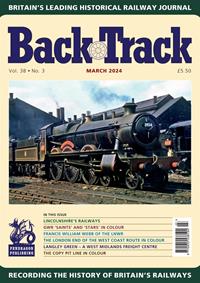|
|
Contents Listing - Articles & Features in this issue
For Shunting the LNER
Taken away by Train
Oil Gas Manufacture and its demise on British Railways 524 First in the Field - Part Two
'Much in Little' - The Railways of Rutland and Stamford - Part One
Brunel the Hospital Builder
Waverley Station
Serious Crime against the Railway - The 1861 Legislation
Taunton and Thereabouts 552
Exercising 'Greyhounds'
The London Midland & Scottish Railway Class 3 2-6-2 Tanks
Nasmyth Gaskell, Edward Bury and Locomotives for the London & Southampton Railway
Turn-of-the-Century Paddington
The Great Western's Cornwall Main Line
Harpenden and the Midland Railway
Readers' Forum
Book Reviews
Cover - LNER Class J50 0-6-0T No.68984 is shunting vans at Leeds Central on 2nd October 1962.
Article Snippets
Evacuees by rail - 80 years on:
In August 1939, as the storm clouds of war gathered over Europe and it seemed inevitable that Britain was about to be drawn into the imminent conflict, plans were put into effect to remove children from vulnerable areas which it was feared would soon be subjected to bombing onslaughts. An article this month looks at the implementation of this mass evacuation, particularly as experienced by the children swept up in it. In this guest editorial Backtrack writer A. J. MULLAY sets the scene for the railways' involvement in 'Operation Pied Piper'.
A new historical bestseller about the build-up to the Second World War mentions evacuation precautions for schoolchildren in the years 1938 and 1939, but only in passing. Tim Bouverie's Appeasing Hitler is actually an astonishing record of Prime Ministerial incompetence as Neville Chamberlain failed to grasp that his attempts at diplomacy were getting nowhere in his dealings with odious dictators in Germany and Italy. Meanwhile, local government officials and railway managers were rather more professional, in preparing to move hundreds of thousands of schoolchildren out of Britain's cities all of 80 years ago this month. More professionally planned, but not unfortunately flawlessly...
When it became obvious that war was inevitable at the end of August 1939 and Nazi bombers were expected imminently, railway managers looked out their plans for a mass movement of children which was unprecendented. As many as 1.5 million were planned to be evacuated, most of them by train. The statistics are a matter of record, but what is less well-known are some of the preoccupations of the traffic managers, the problems they faced and how these were tackled.
Examination of railway archives makes clear that the authorities had no clear idea of what lay ahead of them except the need to take children - and later non-combative adults - out of harm's way. There was an exaggerated assessment of the size and capabilities of the Luftwaffe and the fear of its imminent arrival over cities' skies, probably without even an ultimatum, was unrealistic. Enemy planes would have to operate at the limit of their range after crossing hundreds of miles of North Sea and in any event were fully committed to the attack on Poland at the end of August. This failure to assess the enemy's potential was curious for a nation like the UK which had developed such a heightened capacity for collecting military intelligence in the previous World War. Civil officaIs and railway managers had more time than they realised to organise matters.
But not only did the planners err in terms of timing, there was also a failure in geographical terms. Evacuation destinations were seemingly selected by pepperpot. Many of the receiving areas were industrial towns just as likely to be bombed as larger cities. Eastern counties were included, despite evidence from the previous war, when they were often bombed by those enemy aircraft dumping unused ordnance before returning across the sea. London youngsters were later baffled to find themselves directly under the bombing paths after Dunkirk. Thisshould have been nosurpriseto railway officials, since the Great Eastern Railway had been charged with charting bombers' paths in the days of Zeppelin and Gotha. Similarly, northern destinations for evacuees were selected without any inkling that a country like Norway might be used as a Luftwaffe lauch pad, as it became in 1940. No attempt was made to shorten evacuees' journeys, nor to simplifiy them. There was a policy that only secondary schoolchildren would be senton longer journeys, but this broke down in practice from the very first day. Pity the primary children from Edinburgh having to detrain at Culloden Moor, while others had to travel to the north of Inverness. Some journeys were doubled in length when there were inter-company complications - for example, children from schools in a London & North Eastern Railway-served suburb assigned to a London Midland & Scottish Railway 'refuge' area. One official from the former company declined to query one planned journey which was extended from 30 miles to nearer 80, since it would involve discussions about costings, something which managers on his pay scale made a point of avoiding. Making all this worse was the choice (certainly in the case of the LNER) of carriage 'sets' and, with journeys planned for a Saturday, there was a strong likelihood of non-corridor suburban stock being used - and lacking toilets.
Of course, shortening evacuees' journeys was not necessarily a good idea anyway. Some planned destinations were no more than five miles from the location of the assembly school. Yet there was no evidence available at the time that daylight bombing could be so precise as to land a bomb within even a mile of its intended target and three miles' inaccuracy was commonplace for bombing in darkness for the first half of the war. Again, there was a surprising level of ignorance among the military authorities, when matters like this could have been estimated, if not exactly calibrated.
But children entraining at a terminal had one big advantage over those joining a train at a wayside station. Records show that leaving from a dock platform meant that the 'right away' could be delayed until the children had finished singing their school song. It is a poignant detail from the railway company records of what happened in Britain, 80 years ago this month.
A. J.Mullay
In August 1939, as the storm clouds of war gathered over Europe and it seemed inevitable that Britain was about to be drawn into the imminent conflict, plans were put into effect to remove children from vulnerable areas which it was feared would soon be subjected to bombing onslaughts. An article this month looks at the implementation of this mass evacuation, particularly as experienced by the children swept up in it. In this guest editorial Backtrack writer A. J. MULLAY sets the scene for the railways' involvement in 'Operation Pied Piper'.
A new historical bestseller about the build-up to the Second World War mentions evacuation precautions for schoolchildren in the years 1938 and 1939, but only in passing. Tim Bouverie's Appeasing Hitler is actually an astonishing record of Prime Ministerial incompetence as Neville Chamberlain failed to grasp that his attempts at diplomacy were getting nowhere in his dealings with odious dictators in Germany and Italy. Meanwhile, local government officials and railway managers were rather more professional, in preparing to move hundreds of thousands of schoolchildren out of Britain's cities all of 80 years ago this month. More professionally planned, but not unfortunately flawlessly...
When it became obvious that war was inevitable at the end of August 1939 and Nazi bombers were expected imminently, railway managers looked out their plans for a mass movement of children which was unprecendented. As many as 1.5 million were planned to be evacuated, most of them by train. The statistics are a matter of record, but what is less well-known are some of the preoccupations of the traffic managers, the problems they faced and how these were tackled.
Examination of railway archives makes clear that the authorities had no clear idea of what lay ahead of them except the need to take children - and later non-combative adults - out of harm's way. There was an exaggerated assessment of the size and capabilities of the Luftwaffe and the fear of its imminent arrival over cities' skies, probably without even an ultimatum, was unrealistic. Enemy planes would have to operate at the limit of their range after crossing hundreds of miles of North Sea and in any event were fully committed to the attack on Poland at the end of August. This failure to assess the enemy's potential was curious for a nation like the UK which had developed such a heightened capacity for collecting military intelligence in the previous World War. Civil officaIs and railway managers had more time than they realised to organise matters.
But not only did the planners err in terms of timing, there was also a failure in geographical terms. Evacuation destinations were seemingly selected by pepperpot. Many of the receiving areas were industrial towns just as likely to be bombed as larger cities. Eastern counties were included, despite evidence from the previous war, when they were often bombed by those enemy aircraft dumping unused ordnance before returning across the sea. London youngsters were later baffled to find themselves directly under the bombing paths after Dunkirk. Thisshould have been nosurpriseto railway officials, since the Great Eastern Railway had been charged with charting bombers' paths in the days of Zeppelin and Gotha. Similarly, northern destinations for evacuees were selected without any inkling that a country like Norway might be used as a Luftwaffe lauch pad, as it became in 1940. No attempt was made to shorten evacuees' journeys, nor to simplifiy them. There was a policy that only secondary schoolchildren would be senton longer journeys, but this broke down in practice from the very first day. Pity the primary children from Edinburgh having to detrain at Culloden Moor, while others had to travel to the north of Inverness. Some journeys were doubled in length when there were inter-company complications - for example, children from schools in a London & North Eastern Railway-served suburb assigned to a London Midland & Scottish Railway 'refuge' area. One official from the former company declined to query one planned journey which was extended from 30 miles to nearer 80, since it would involve discussions about costings, something which managers on his pay scale made a point of avoiding. Making all this worse was the choice (certainly in the case of the LNER) of carriage 'sets' and, with journeys planned for a Saturday, there was a strong likelihood of non-corridor suburban stock being used - and lacking toilets.
Of course, shortening evacuees' journeys was not necessarily a good idea anyway. Some planned destinations were no more than five miles from the location of the assembly school. Yet there was no evidence available at the time that daylight bombing could be so precise as to land a bomb within even a mile of its intended target and three miles' inaccuracy was commonplace for bombing in darkness for the first half of the war. Again, there was a surprising level of ignorance among the military authorities, when matters like this could have been estimated, if not exactly calibrated.
But children entraining at a terminal had one big advantage over those joining a train at a wayside station. Records show that leaving from a dock platform meant that the 'right away' could be delayed until the children had finished singing their school song. It is a poignant detail from the railway company records of what happened in Britain, 80 years ago this month.
A. J.Mullay
Adverts and Links based on this content
Advertisement




